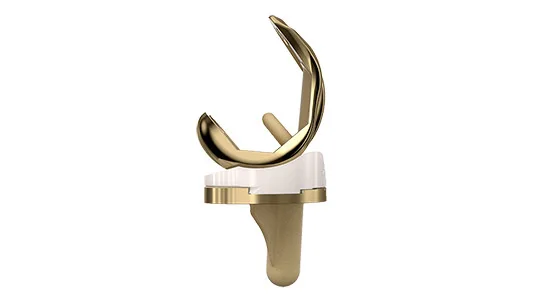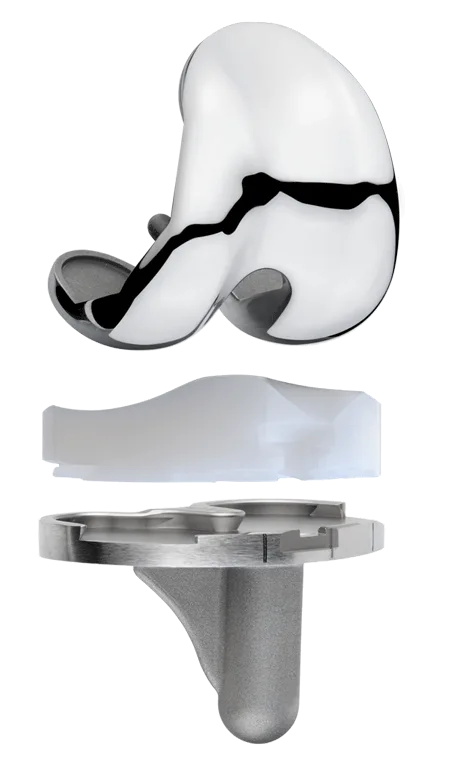Evolution® knee with NitrX™ coating
The Evolution® knee with NitrX™ coating promotes natural kinematics with the added benefit of a Titanium Niobium Nitride Coating.

EVOLUTION® KNEE SYSTEMS
The Evolution® medial-pivot knee system is designed to answer the limitations of traditional implants by delivering superior flexion stability, anatomic motion, and wear–limiting design characteristics.
IMPROVED STABILITY AND VALIDATED OUTCOMES
The Evolution® medial-pivot knee system is built upon a legacy of 95% patient satisfaction with 98.8% survivorship at 17 years1, and features a design that enhances quadriceps efficiency, allowing for improved proprioception and more normal feeling knee.
Evolution® knee with NitrX™ coating
The Evolution® knee with NitrX™ coating promotes natural kinematics with the added benefit of a Titanium Niobium Nitride Coating.

The Evolution® knee with NitrX™ coating features a titanium niobium nitride (TiNbN) coating that has been shown to reduce the release of cobalt (Co), chromium (Cr), nickel (Ni), and molybdenum (Mb) ions common in standard CoCr implants.7 The Evolution® knee with NitrX™ coating maintains the kinematic benefits of the medial-pivot design8, resulting in optimal stability.9
Evolution® Cemented Knee Systems
The Evolution® medial-pivot knee system delivers flexion stability, anatomic motion, and a wear–limiting design.

NATURAL KINEMATICS
To achieve postoperative satisfaction, patients want their implant to deliver high functionality and a more natural feeling. The single-radius design of the Evolution® knee system provides stability through all phases of flexion. AP translation is also decreased to help achieve a more normal feel. This represents a dramatic advance over traditional knee replacements, which have been shown to exhibit anterior-posterior translation that can decrease stability and cause early revisions.2,3
SURGEON INSIGHT
“The return of range of motion is much faster, they get much better motion and they get it quicker. They're out of the hospital sooner, their pain is better and they seem to get back to the activities that they want to do at a much quicker rate.”
- Dr. Joseph Assini MD, Englewood, CO
THE DIFFERENCE IS IN THE DESIGN
Why set out to design a better knee system? Today, according to the latest literature, nearly 20% of all patients are unhappy with their total knee replacement due to residual pain, functional issues and early implant failure.8

QUADRICEPS EFFICIENCY
The Evolution® medial-pivot knee system enhances quadriceps efficiency and reduces the quadriceps avoidance found in traditional knee replacements. By enhancing quadriceps efficiency, the patient can have increased proprioception and a more normal feeling knee.10

CRUCIATE SACRIFICING DESIGN
The Evolution® medial-pivot insert features an anterior raised lip, to replicate the function of the PCL, and a posterior raised lip, to replicate the function of the ACL, acting like an ACL-PCL substituting knee.

MORE NATURAL FEELING KNEE MOVEMENT
In-vivo long-term clinical studies have consistently shown that medial-pivot design achieves equal or higher degrees of flexion than traditional posterior stabilized (PS) knee design, with an average of 124°.11;12-13

STABLE RANGE OF MOTION
It is routine for patients to complain of instability following a traditional knee replacement. Studies also clearly show instability to be the leading cause of early revisions.4-6 By delivering a more secure, highly conforming articulation, the Evolution® medial-pivot knee system provides the kind of stability throughout the range of motion that patients seek.

DESIGN FEATURES
• Flexion stability
• Promoted through high medial conformity and constant radius spherical condyles.
• Increased flexion and enhanced quadriceps efficiency achieved through longer constant flexion radius with more posterior, medial dwell point
• Anatomic motion
• Driven through a stable medial compartment and a mobile lateral compartment that rotates or pivots about the medial.
• Wear-limiting design14-21
• Enabled through a maximized contact area and repeatable motion path that minimizes contact stresses.
REFERENCES